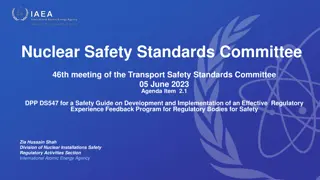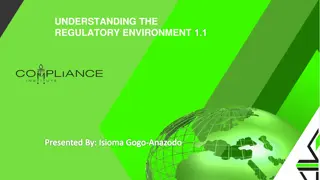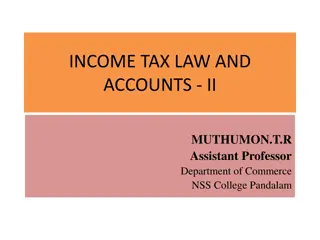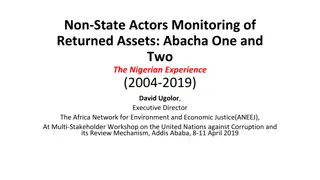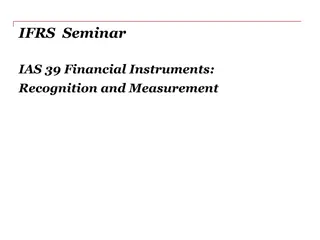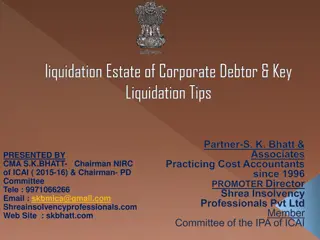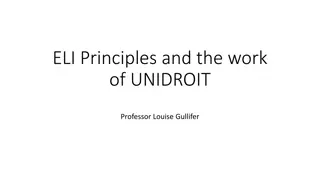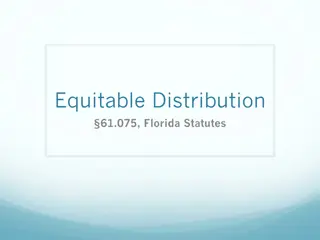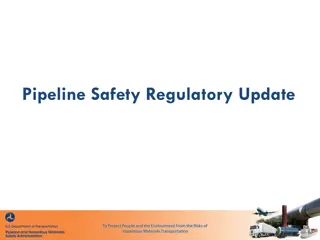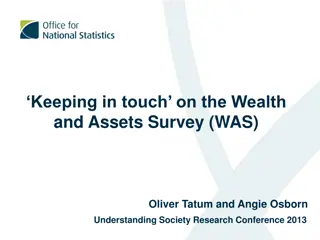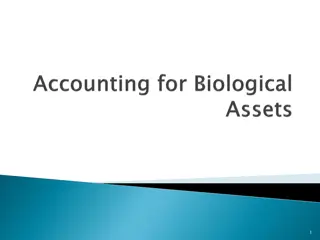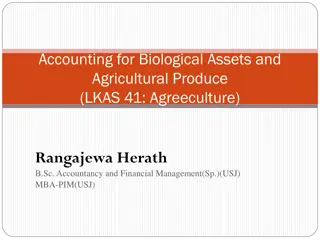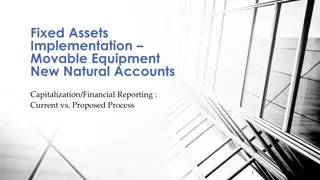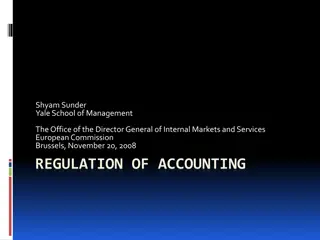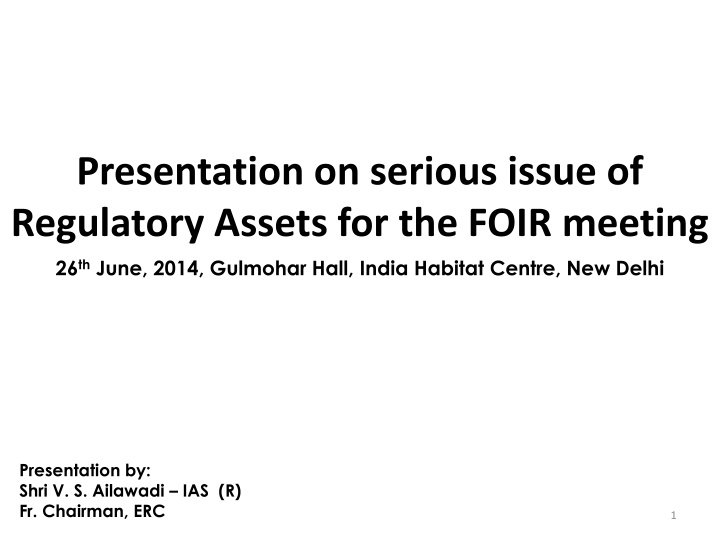
Regulatory Assets in the Power Sector
Explore the concept of Regulatory Assets (RAs) and their implications in the power sector, focusing on the challenges faced by distribution utilities in managing these assets. Learn about the accumulated RAs, their impact on financial health, and potential solutions to address the issue for sustainable energy distribution.
Download Presentation

Please find below an Image/Link to download the presentation.
The content on the website is provided AS IS for your information and personal use only. It may not be sold, licensed, or shared on other websites without obtaining consent from the author. If you encounter any issues during the download, it is possible that the publisher has removed the file from their server.
You are allowed to download the files provided on this website for personal or commercial use, subject to the condition that they are used lawfully. All files are the property of their respective owners.
The content on the website is provided AS IS for your information and personal use only. It may not be sold, licensed, or shared on other websites without obtaining consent from the author.
E N D
Presentation Transcript
Presentation on serious issue of Regulatory Assets for the FOIR meeting 26th June, 2014, Gulmohar Hall, India Habitat Centre, New Delhi Presentation by: Shri V. S. Ailawadi IAS (R) Fr. Chairman, ERC 1
Concept of Regulatory Asset The concept of Regulatory Assets (RAs) in the power sector is embedded in the cost plus Regulation. It is an expedient approach for a regulator in dealing with the demand of the distribution utilities for increasing rates in the interest of the rate payers. For fear of a consumer backlash and/or to avoid the required retail tariff increases, the revenue recovery although recognised, is deferred for the future. Normally, deferred realisation of the RAs is recovered in subsequent rate revision. The rise in RAs occurred in some states on the belief that it could be adjusted / achieved through efficiency gains expected out of the reform process and efficiency improvements.. However, this has not happened and RAs have grown in size ( excess of Rs. 70,000 cr.), as of now. 2
Accumulated RAs & Implications The steady increase in the RAs occurred as no definite time frame for phasing out was determined alongwith approval of ARR of the utilities by the regulator. Besides, there may have been specific reasons/ compulsions. Accumulated RAs have a considerable impact across 15 distribution utilities, more serious & essentially confined to about 8 States in India. The Regulators do permit carrying costs of RAs to the distribution utilities to manage their cash-flow requirements. However, interest cost allowed for short term borrowing costs, to meet the shortfall in revenue is not sufficient. This effects the ability of the distribution utilities to raise commercial debt in the market, as their balance sheets get compromised on account of building up its RAs. Lack of fresh investments for improving the network and the service standards, result in poor QoS for the customer as highlighted by recent instances of outages and power cuts by several discoms. 3
Way Forward Cont Growing concerns on the liquidation of RAs the Appellate Tribunal of Electricity (APTEL) issued a suo-moto order on November 11, 2011 directing State Commissions to act on the same. The way to liquidate the accumulated RAs may not be possible to be done in one go. The State Regulators are aware of the factors underlining the increase in RAs. The responsibility for liquidating RAs through MYT regulations largely rests on the Regulators. To mitigate the effect of large buildup of RAs, plan for phased liquidation of RAs the following options could be explored: Issuance of Tax Free Bonds by Discoms Issuance of Tax Free Bonds by PFC/REC for the purpose of lending to the distribution entities, strictly for liquidation of RAs - to be paid back by the distribution entities over a period of time. 4
Way Forward Cont Direct Financing of the RAs by Power Finance Corporation/ Rural Electrification Corporation strictly for RAs - expecting a lower rate of interest to be charged in this case, compared to commercial borrowings. There is an existing scheme of PFC and REC for funding the RAs, which requires state guarantee. This is available for 100% state owned utilities. The same product should be made available to Private Distribution entities/ JV Companies, without the condition of State Guarantee/ Corporate Guarantee. The above options compare favorably with existing route for discoms for commercial borrowings @ 12.5 13% & ensure customers interest and achieve win win situation for all stake holders. (Slides 6 & 7) FOIR and/or FOR may provide a uniform approach to ensure recovery of the assets through a clear road map and a time frame (which should be same for all the utilities operating in the circle). 5
Way Forward Cont Issuance of Tax Free Bond by DISCOMs (@8%) Issuance of Tax Free Bond by PFC/REC (@8.5%) Direct Financing by PFC/REC (@10.5%) Options Key Government agencies involved RBI, MoF, MoP RBI, MoF, MoP MoP Well established process for state utilities- to be extended for private utilities as well Involves co-ordination with several agencies Involves co-ordination with several agencies Ease of Execution 4-5 % points saving in funding cost of regulatory assets compared to Commercial Loans 3.5-4.5 % points saving in funding cost of regulatory assets compared to Commercial Loans 1-1.5% points saving in funding cost of regulatory assets compared to Commercial Loans Reduction in Tariff Tax benefit up to 30% of the amount invested Tax benefit up to 30% of the amount invested Not applicable as there is no bond holder in this transaction Benefit to Bond holder Tax benefit on the interest Tax benefit on the interest 6
Advantage All: Gains for every stakeholder Government If used as an alternative for financial restructuring, state governments will not require to give support for interest and principal payment Augmentation of Distribution Infrastructure and thereby achievement of mission of Power for All Investors Improved viability of distribution sector will enhance the investors confidence Regulators This will give the regulator increased time to recover regulatory assets through tariff hikes and hence reduce the pressure on the regulator Bond Holders Tax benefit of upto 30% of the amount invested in the bonds and also on the interest on investment in bonds Interest rates of 8% compatible to the interest on FD (with extra tax benefits) Consumers Reduction in tariff rates Benefits available to bondholders can be availed by investing into the bonds Improved network and hence reliable supply Benefits of loss reduction in the form of reduction in tariff Discoms Effective alternative for procurement of funds Alternative for financial restructuring of State Electricity Boards (SEBs) Stable availability of funds Increase in liquidity for Expansion of Distribution Infrastructure Generators A viable distribution sector ensures that the payment to the generators is secured Generators do not have any tool like regulatory assets to show their debts and thus long non payment of dues become non performing assets, affecting the balance sheet and borrowing capacity Lenders If used as an alternative for financial restructuring, lenders need not give moratorium for payment of principal payment to DISCOMs Improved financials of the discoms would allow lenders to extend fresh loans 7 7
To Resolve Regulatory firmness to pursue the matter is important to get much needed solution to this problem. Regulators may also commit themselves to ensure that no such liabilities get created in future to restore financial health of the discoms, going forward. Thank you for your time 8


